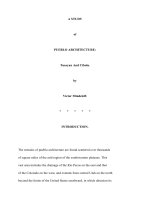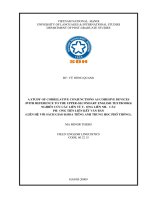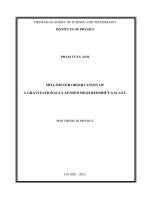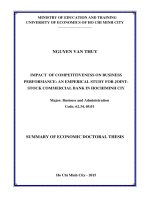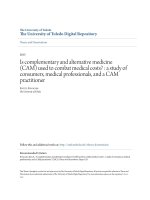A Study of Cognitive NonFactive Verb and Epistemic Adverb Collocations in English (Luận án tiến sĩ)
Bạn đang xem bản rút gọn của tài liệu. Xem và tải ngay bản đầy đủ của tài liệu tại đây (1.76 MB, 272 trang )
MINISTRY OF EDUCATION AND TRAINING
THE UNIVERSITY OF DANANG
TRẦN THỊ MINH GIANG
A STUDY OF COGNITIVE NON-FACTIVE VERB
AND EPISTEMIC ADVERB COLLOCATIONS
IN ENGLISH
DOCTORAL THESIS IN SOCIAL SCIENCES
AND HUMANITIES
Danang, 2018
MINISTRY OF EDUCATION AND TRAINING
THE UNIVERSITY OF DANANG
TRẦN THỊ MINH GIANG
A STUDY OF COGNITIVE NON-FACTIVE VERB
AND EPISTEMIC ADVERB COLLOCATIONS
IN ENGLISH
Major: ENGLISH LINGUISTICS
Code: 62.22.02.01
DOCTORAL THESIS IN SOCIAL SCIENCES
AND HUMANITIES
SUPERVISOR: Assoc.Prof.Dr. LƯU QUÝ KHƯƠNG
Danang, 2018
i
STATEMENT OF AUTHORSHIP
Except where reference is made in the text of the thesis, this thesis contains no
material published elsewhere or extracted in whole or in part from a thesis by which
I have qualified for or been awarded another degree or diploma.
No other person’s work has been used without due acknowledgements in the
thesis. This thesis has not been submitted for the award of any degree or diploma in
any other tertiary institution.
Danang, January 2018
Tran Thi Minh Giang
ii
ABSTRACT
The dissertation is an attempt to describe linguistic features of the structure
that consists of the singular first person subject pronoun I and cognitive non-factive
verb and epistemic adverb collocations in English in terms of epistemic modality
framework. Based on the descriptive method and the collected data of 1000 English
samples randomly gathered from different sources such as novels, short stories and
online materials, the study presented a detailed description of the structure I +
cognitive non-factive verb and epistemic adverb collocations in three linguistic
aspects: syntactics, semantics, and pragmatics. More importantly, a linguistic
portray of the interplay of these three linguistic dimensions was depicted to serve
the main aim of the research. It is hoped that the findings from the research will not
only make a great contribution to further understanding of modality in linguistics,
but also become very useful to language users in the use of the English structure I +
cognitive non-factive verb and epistemic adverb collocations in communication.
Noticeably, the study provides learners of English and even native speakers of
English with a practical knowledge of using the structure. Especially, since the
study presented detailed and overall view of the structure I + cognitive non-factive
verb and epistemic adverb collocations, it is really a good source of reference for
teachers of English to apply the English structure in teaching English more
effectively. In addition, the study of the structure I + cognitive non-factive verb and
epistemic adverb collocations in English also opens the paths for interesting
questions relative to epistemic modality in particular, and linguistics in general.
iii
TABLE OF CONTENTS
STATEMENT OF AUTHORSHIP ......................................................................... i
ABSTRACT .............................................................................................................. ii
TABLE OF CONTENTS ........................................................................................ iii
LIST OF ABBREVIATIONS...................................................................................x
LIST OF TABLES ................................................................................................. xii
LIST OF FIGURES .............................................................................................. xiv
CHAPTER 1. INTRODUCTION ............................................................................1
1.1. Rationale ..............................................................................................................1
1.2. Aims and Objectives of the Study........................................................................3
1.2.1. Aims of the Study .........................................................................................3
1.2.2. Objectives of the Study .................................................................................3
1.3. Research Questions ..............................................................................................4
1.4. Object of the Study...............................................................................................4
1.5. Scope of the Study ...............................................................................................4
1.6. Significance of the Study .....................................................................................5
1.6.1. Theoretical Significance ...............................................................................5
1.6.2. Practical Significance ...................................................................................5
1.7. Organization of the Study ....................................................................................6
CHAPTER
2.
LITERATURE
REVIEW
AND
THEORETICAL
BACKGROUND .......................................................................................................7
2.1. Review of Previous Researches Related to the Study .........................................7
2.1.1. Syntactics ......................................................................................................7
2.1.2. Semantics ....................................................................................................11
2.1.3. Pragmatics ...................................................................................................16
2.1.4. A Combination of Three Aspects ...............................................................20
2.2. Theoretical Background .....................................................................................24
2.2.1. Modality and Epistemic Modality ..............................................................24
iv
2.2.1.1. Traditional Logic Modality .................................................................24
2.2.1.2. Linguistic Modality .............................................................................26
2.2.1.3. The Distinction between Modality and Proposition ............................27
2.2.1.4. The Distinction between Deontic and Epistemic Modality ................28
2.2.1.5. Types of Epistemic Modality ..............................................................29
2.2.2. Collocations of Cognitive Non- Factive Verb and Epistemic Adverbs .....31
2.2.2.1. Modal Lexical Verbs ...........................................................................31
a. Mental Space Theory ..................................................................................31
b. Cognitive Non-Factive Verbs .....................................................................32
c. Characteristics of Cognitive Non-Factive Verbs ........................................34
2.2.2.2. Modal Adverbs ....................................................................................35
a. Epistemic Adverbs ......................................................................................35
b. Types of Epistemic Adverbs in English .....................................................36
c. Characteristics of Epistemic Adverbs.........................................................38
2.2.2.3. Cognitive Non- Factive Verb and Epistemic Adverb Collocations ....43
a. The Definition of the Term collocation ......................................................43
b. Modally Harmonic Combinations of a Modal Verb and a Modal
Adverb .......................................................................................................................44
2.2.3. Linguistic Features of CNFV and EA Collocations ...................................46
2.2.3.1. Syntactics .............................................................................................46
a. Mobility of Modality Collocations in the Same Clause .............................46
b. Moved Negation and Epistemic Modality .................................................47
2.2.3.2. Semantics .............................................................................................48
a. Epistemic Scale ...........................................................................................48
b. Epistemic Modality Based on Deduction ...................................................51
c. Speech-Act Related Modality .....................................................................52
2.2.3.3. Pragmatics ...........................................................................................55
a. Pragmaticalization and Pragmatic Markers ................................................55
v
b. Factors Affecting the Mobility of the Structure I + CNFV and EA
Collocations...............................................................................................................56
c. The ‘Conversational Maxim’ View in Communicative Strategies ............57
d. The ‘Face-Saving’ View in Politeness Theory ..........................................58
2.3. Summary ............................................................................................................63
CHAPTER 3. RESEARCH METHODOLOGY ..................................................64
3.1. Research Design .................................................................................................64
3.2. Research Methods ..............................................................................................64
3.3. Data Collection...................................................................................................65
3.3.1. Description of Samples ...............................................................................65
3.3.1.1. Authenticity .........................................................................................66
3.3.1.2. Accessibility ........................................................................................66
3.3.1.3. Variation ..............................................................................................66
3.3.1.4. Reputation ...........................................................................................67
3.3.2. Data Collection Procedure ..........................................................................67
3.3.3. Data Analysis Procedure .............................................................................68
3.4. Procedures of the Study .....................................................................................69
3.5. Analytical Framework of the Study ...................................................................70
3.6. Reliability and Validity ......................................................................................72
3.7. Summary ............................................................................................................72
CHAPTER 4. SYNTACTIC FEATURES OF THE STRUCTURE I +
CNFV AND EA COLLOCATIONS ......................................................................74
4.1. Analysis of the Structure I + Cognitive Non-Factive Verb and Epistemic
Adverb Collocations..................................................................................................74
4.2. Harmony of Cognitive Non-Factive Verbs and Epistemic Adverbs in the
Structure I + CNFV and EA Collocations ................................................................76
4.2.1. The Structure I think + EAs ........................................................................76
4.2.2. The Structure I believe + EAs ....................................................................80
4.2.3. The Structure I hope + EAs ........................................................................83
vi
4.2.4. The Structure I guess + EAs .......................................................................86
4.2.5. The Structure I suppose + EAs ...................................................................86
4.2.6. The Structure I assume + EAs ....................................................................87
4.3. Frequency of the Structure I + CNFV and EA Collocations .............................89
4.4. Mobility of Epistemic Adverbs in the Matrix Clause ........................................90
4.5. Syntactic Positions of the Structure I + CNFV and EA Collocations in the
Superordinate Clause ................................................................................................92
4.5.1. Initial ...........................................................................................................92
4.5.2. Medial .........................................................................................................93
4.5.3. Final ............................................................................................................94
4.5.4. Frequency of the Structure I + CNFV and EA Collocations in Initial,
Medial, and Final Positions .......................................................................................95
4.6. Complementizer “that” in a Superordinate Clause ............................................96
4.6.1. Complementizer “that” with Epistemic Adverbs in the Structure I +
CNFV and EA Collocations ......................................................................................97
4.6.2. Omission of Complementizer “that” in the Superordinate Clause .............98
4.7. Raising of Negative Form in Sentences with the Structure I + Cognitive
Non-Factive Verb and Epistemic Adverb Collocations ..........................................100
4.8. Summary ..........................................................................................................104
CHAPTER 5. SEMANTIC FEATURES OF THE STRUCTURE I + CNFV
AND EA COLLOCATIONS ................................................................................105
5.1. Deduction-Based Semantic Features ...............................................................105
5.1.1. The Structure I + CNFV and EA Collocations Expressing Belief ...........105
5.1.2. The Structure I + CNFV and EA Collocations Expressing Inference ......108
5.1.3. The Structure I + CNFV and EA Collocations Expressing Prediction ....111
5.1.4. Frequency of the Structure I + CNFV and EA Collocations Showing in
Belief, Inference and Prediction ..............................................................................114
5.2. Modal Meanings of the Structure I + CNFV and EA Collocations .................114
5.2.1. Tentativeness ............................................................................................115
vii
5.2.2. Assertion ...................................................................................................116
5.2.3. Negation ....................................................................................................117
5.3. Scale of Certainty- Based Semantic Features ..................................................118
5.3.1. High Certainty...........................................................................................119
5.3.2. Mid Certainty ............................................................................................121
5.3.3. Low Certainty ...........................................................................................123
5.4. Semantic Features of the Structure I think + EAs Based on the Scale of
Negation ..................................................................................................................126
5.5. Summary ..........................................................................................................128
CHAPTER 6. PRAGMATIC FEATURES OF THE STRUCTURE I +
CNFV AND EA COLLOCATIONS ....................................................................130
6.1. The Structure I + Cognitive Non-Factive Verb and Epistemic Adverb
Collocations Used in Politeness Strategies .............................................................130
6.1.1. Negative Politeness Strategy ....................................................................131
6.1.1.1. Mitigating the Reproach ....................................................................131
6.1.1.2. Avoiding the Imposition of Knowledge ............................................132
6.1.1.3. Revealing the Speaker’s Unflattering Things ...................................133
6.1.2. Positive Politeness Strategy ......................................................................134
6.1.2.1. Mitigating Illocutionary Force to Downgrade the Positive Face of
the Speaker ..............................................................................................................135
6.1.2.2. Enhancing the Hearer’s Good Virtues to Respect His Positive Face 136
6.1.2.3. Mitigating the Illocutionary Force of Claims of Knowledge by
Negating the Speaker’s Knowledge ........................................................................137
6.2. The Communicative Strategies Using the Structure I + CNFV and EA
Collocations.............................................................................................................139
6.2.1. Hedges ......................................................................................................139
6.2.2. Mitigation in the Mobility of the Structure I + CNFV and EA
Collocations.............................................................................................................141
viii
6.3. Pragmatic Meanings in Negation of the Structure I + Cognitive Non-Factive
Verb and Epistemic Adverb Collocations ...............................................................143
6.3.1. Hearer-Oriented Pragmatic Meanings of Moved Negation of the
Structure I + Cognitive Non-Factive Verb and Epistemic Adverb Collocations ...143
6.3.2. Mitigating the Illocutionary Force of Claims of Knowledge by Using
Moved Negation of the structure I + Cognitive Non-Factive Verb and Epistemic
Adverb Collocations................................................................................................144
6.4. Speech Act – Based Pragmatic Features Expressed by the Structure I +
CNFV and EA Collocations ....................................................................................147
6.4.1. Complaining or Admonishing ..................................................................147
6.4.2. Counselling ...............................................................................................149
6.4.3. Reducing Boasting ....................................................................................150
6.5. Summary ..........................................................................................................152
CHAPTER 7. INTERPLAY OF SYNTACTICS, SEMANTICS, AND
PRAGMATICS IN THE STRUCTURE I + CNFV AND EA
COLLOCATIONS ................................................................................................154
7.1. Mobility of Epistemic Adverbs in the Structure I + CNFV and EA
Collocation ..............................................................................................................154
7.2. Interplay of Three Linguistic Dimensions in the Combination of Just and
Other EAs in the Matrix Clause ..............................................................................157
7.3. Interplay of Three Linguistic Aspects in Mobility of the Structure I + CNFV
and EA Collocations in a Superordinate Clause .....................................................160
7.4. Interplay of Three Linguistic Aspects in the Emphasis by Using Auxiliary
Verbs Do in the Structure I + CNFV and EA Collocations ....................................162
7.5. Interplay of Three Linguistic Aspects in Application of the Relevance
Theory by Sperber in the Structure I + CNFV and EA Collocations .....................164
7.6. Interaction of Three Linguistic Aspects in Negative Move of the Structure I
+ CNFV and EA Collocations ................................................................................166
ix
7.7. Interplay of Three Linguistic Dimensions in the Structure I + CNFV and EA
Collocations Based on Deduction ...........................................................................169
7.7.1. Belief .........................................................................................................169
7.7.2. Inference ...................................................................................................171
7.7.3. Prediction ..................................................................................................172
7.8. Summary ..........................................................................................................174
CHAPTER 8. CONCLUSION .............................................................................176
8.1. Recapitulation ..................................................................................................176
8.2. Conclusions ......................................................................................................179
8.3. Implications ......................................................................................................180
8.3.1. For English Language Learning and Teaching .........................................180
8.3.2. For Language Research ............................................................................181
8.4. Limitations of the Thesis and Suggestions for Further Studies .......................182
8.4.1. Limitations of the Thesis ..........................................................................182
8.4.2. Suggestions for Further Studies ................................................................183
THE AUTHOR’S ARTICLES RELATED TO THE STUDY .........................184
REFERENCES ......................................................................................................185
APPENDIX ............................................................................................................210
APPENDIX A ........................................................................................................210
APPENDIX B ........................................................................................................215
APPENDIX C ........................................................................................................229
APPENDIX D ........................................................................................................254
x
LIST OF ABBREVIATIONS
ACAD
: academic prose
Adv
: adverb
Art
: article
Aux
: auxiliary
C0
: collocation
CONV
: conversation
CNFVs
: cognitive non-factive verbs
D
: distance
Det
: determinant
EAs
: epistemic adverbs
FICT
: fiction writing
FTA
: face threatening act
H
: hearer
M
: modality
N
: noun
NEWS
: news writing
NP
: noun phrase
P
: proposition
Pred
: predicate
Pro
: pronoun
Pre
: preposition
PP
: prepositional phrase
Rp
: relative power
Rx
: relative ranking
S
: speaker
S (in tree diagrams)
: sentence
S’ (in tree diagrams)
: subordinate clause
xi
V
: verb
VP
: verbal phrase
Wx
: weightiness
xii
LIST OF TABLES
Table 2.1. Positions of epistemic adverbs across registers (Biber, 1999, p.872)......41
Table 4.1. Harmony of the pattern I think and strong epistemic adverbs .................77
Table 4.2. Harmony of the pattern I think and medium epistemic adverbs ..............78
Table 4.3. Harmony of the pattern I think and low epistemic adverbs .....................79
Table 4.4. Harmony of the pattern I believe and strong epistemic adverbs ..............80
Table 4.5. Harmony of the pattern I believe and medium epistemic adverbs ...........82
Table 4.6. Harmony of the pattern I believe and low epistemic adverbs ..................82
Table 4.7. Frequency of the pattern I believe and EAs .............................................83
Table 4.8. Harmony of the pattern I hope and strong epistemic adverbs .................83
Table 4.9. Harmony of the pattern I hope and medium epistemic adverbs ..............84
Table 4.10. Harmony of the pattern I hope and low epistemic adverbs ...................85
Table 4.11. Frequency of the pattern I hope and EAs...............................................85
Table 4.12. Harmony of the pattern I guess and epistemic adverbs .........................86
Table 4.13. Harmony of the pattern I suppose and epistemic adverbs .....................87
Table 4.14. Harmony of the pattern I assume and epistemic adverbs ......................87
Table 4.15. Summary of harmony of CNFVs and EAs in the structure I + CNFV
and EA collocations ..................................................................................................88
Table 4.16.
Frequency of six patterns of the structure I +CNFV and EA
collocations ...............................................................................................................89
Table 4.17. Frequency of the structure I + CNFV and EA collocations in Initial,
Medial, Final Positions..............................................................................................95
Table 4.18. Positions in correlation with the employment of “that”with epistemic
adverbs in the matrix Clause .....................................................................................98
Table 4.19. Positions of complementizer ‘that’ in the superordinate clause ............99
Table 4.20. The omission of complementizer “that” in English sentences ..............99
Table 4.21. Frequency of the moved negation in English sentences with the
structure I + CNFV and EA collocations ................................................................103
xiii
Table 5.1. Semantics features of the structure I + CNFV and EA collocations in
English based on deduction .....................................................................................113
Table 5.2. Frequency of the structure I + CNFV and EA collocations in Belief,
Inference, and Prediction ........................................................................................114
Table 5.3. Scale of certainty of the structure I + CNFV and EA collocations in
English .....................................................................................................................125
Table 6.1. The structure I + CNFV and EA collocations with positive and
negative politeness strategies ..................................................................................138
Table 6.2. Pragmatic features of the structure I + CNFV and EA collocations
based on Speech Act theory ....................................................................................151
Table 6.3. Frequency of pragmatic features of the structure I + CNFV and EA
collocations based on Speech Act theory ................................................................152
Table 7.1. Interplay of three linguistic aspects based on the mobility of EAs in
the structure I + CNFV and EA collocations ..........................................................156
Table 7.2. Frequency of mobility of EAs in the matrix clause ..............................156
Table 7.3. Positions of Just in the matrix clause .....................................................158
Table 7.4. Three linguistic dimensions in combination of Just and other EAs ......159
Table 7.5. Interplay of three linguistic aspects in the mobility of the structure I +
CNFV and EA collocations in a sentence ...............................................................161
Table 7.6. EAs in the emphasis by using the auxiliary Do in the structure I +
CNFV and EA collocations .....................................................................................163
Table 7.7. Interplay of three linguistic aspects in the emphasis with Do in the
structure I + CNFV and EA collocations ................................................................164
Table 7.8. Interplay of three linguistic aspects in negative move of the structure I
+ CNFV and EA collocations .................................................................................168
Table 7.9. Interplay of three linguistic aspects based on deduction of the
structure I + CNFV and EA collocations ................................................................173
xiv
LIST OF FIGURES
Figure 2.1. Summary of types of modality by Nguyễn Văn Hiệp (2007) ................30
Figure 2.2. Scale of certainty of assertive epistemic adverbs ...................................37
Figure 2.3. Scale of possibility of non-assertive epistemic adverbs .........................37
Figure 2.4. Adaptation of Givón’s (1982) scale of epistemic space .........................49
Figure 2.5. Two dimensions of epistemicity .............................................................50
Figure 2.6. Evidentality (Cappelli, 2008) .................................................................50
Figure 2.7. Grammaticalization and pragmaticalization ...........................................56
Figure 2.8. Brown and Levinson’s strategies for doing an FTA (1987, p.60) ..........60
Figure 2.9. Nguyễn Quang’s strategies for doing an FTA (2002, p.53) ...................62
Figure 3.1. Theoretical framework of collocations of CNFVs and EAs ..................71
Figure 4.1. Tree diagram showing the deep construction of the structure I +
CNFV and EA collocation in a sentence ..................................................................75
Figure 4.2. Matrix and subordinate clause in the superordinate clause ...................91
Figure 4.3. Tree diagram with negative particle Not in the subordinate clause .....102
Figure 4.4. Tree diagram with the negative move from the subordinate clause to
the matrix clause .....................................................................................................102
Figure 5.1. Formula of the structure I + CNFV and EA collocations expressing
Belief .......................................................................................................................108
Figure 5.2. Formula of the structure I + CNFV and EA collocations expressing
Inference ..................................................................................................................110
Figure 5.3. Formula of the structure I + CNFV and EA collocations expressing
Prediction ................................................................................................................112
Figure 5.4. Formula of high certainty semantic feature ..........................................121
Figure 5.5. Formula of mid certainty semantic feature ...........................................123
Figure 5.6. Formula of low certainty semantic feature ...........................................125
Figure 5.7. Scale of negation of the structure I think + EAs ..................................127
Figure 6.1. Inner compelling force of the negative move .......................................147
1
CHAPTER 1
INTRODUCTION
1.1. Rationale
In daily communication, our ultimate goal is not only to impart information
described in utterances but also to display our commitment to the truth of what is
said, or the content of the proposition. Linguists attribute the speaker’s attitude to
the states of affairs modality in general and epistemic modality in particular. Up to
now modality has been a fascinating area to linguists because studying modality is
necessary to the development of linguistics. Without modality, we cannot
understand the nature of language as “strategic linguistic tools for the construction
of social reality” (Bybee, 1995, p. 8). In fact, an utterance only consists of separate
parts. Meanwhile modality, the indispensable factor plays an important role in
imparting the speaker’s thoughts and attitude to the hearer; therefore, Bally says that
modality is the soul of the utterance, as cited in Nguyễn Văn Hiệp (2008, p.74).
As a matter of fact, English possesses a variety of lexical means to express
modality including modal nouns, adjectives, adverbs and lexical verbs. Yet,
according to Perkins “Doing research on modality is very similar to trying to move
in an overcrowded room without treading on anyone else’s feet” (1983, p.4). In the
same line, Jongeboer remarks:
Comparing the relevant grammars and the monographs to […] modal
aspects in general, one is astonished to find that in seemingly no other field
of grammar so much disagreement prevails as in what I summarize under
the term of modality. It is the true sense of the word a maze in which every
grammarian is searching for his way. (Wynmann, 1996, p.14).
Despite so many researches of modality, there are still several different
aspects of modality which have not been investigated in earlier works yet.
According to Hoye’s remark, “Modal elements frequently combine and interact
2
dynamically” (1997, p.3). It is one of the most interesting properties in modality that
attract linguists’ attention nowadays. Therefore, the study of collocations has
always been an important aspect of linguistic research and until now essential
progress has been made in the aspect of lexicology based upon the research of
occurrence and collocation to find out the effect of collocations in modality.
In fact, everyday words not only have a distinct meaning or meanings but
also are a plentiful combination of multi-word patterns which make up a text.
Especially in epistemic modality, there is also high probability for the combination
of varied modal elements. Among them, cognitive non-factive verbs and epistemic
adverbs are often used to hedge or mitigate the speaker’s imposition and give the
addressee a chance to argue about the truth, or the falsity of states of affairs.
Hedging items or modulations combined a cognitive non-factive verb and an
epistemic adverb with the singular first person subject such as I certainly think, I
possibly believe, maybe I guess, I suppose perhaps … in English may be an
interesting and useful aspect to all language learners of English as in the following
examples
(1.1) “I think perhaps I can too. But I try not to borrow. First you borrow.
Then you beg.”
(The old man and the sea, 1952, p.10)
(1.2) “I guess maybe we'll starve, but he won't care. He's so mean!"
(Gone with the wind, 1947, p.440)
(1.3) “I don’t know why I worried about it before. It seems easy enough
now. I hope they get the planes up on time for once. I certainly hope that tomorrow
is going to be a day with dust on the road.”
(Vanity fair, 1996, p.308)
In communication, the English are often in the habit of using the structure I
+ CNFV and EA collocations in communication by adding I think perhaps, I guess
maybe, I certainly hope... like in (1.1), (1.2) and (1.3) at the beginning of their
utterances because they want to express their attitude to the content of the
proposition. Besides, the structure can be used as hedges in cooperative principle
and politeness strategies.
3
Until now although there has been a wide range of research on modality
among which are studies on the combination of a modal verb and a modal adverb
such as Cappelli (2005), Coates (1983), McIntosh (1961), Hoye (1997), Lyons
(1977), Perkins (1983), …there has been no study on a comprehensive overview of
modality expressions showing the speaker’s attitude in the utterance in three
aspects: syntactics, semantics, and pragmatics. Consequently, a study of the
structure that consists of the singular first person subject pronoun I and a cognitive
non-factive verb and epistemic adverb collocation still remains an unexploited area.
Therefore, the thesis entitled A study of cognitive non-factive verb and epistemic
adverb collocations in English is hoped, once finished, may help both learners of
English and native speakers of English use the structure effectively in
communication. Now that in our study, linguistic features of cognitive non-factive
verb and epistemic adverb collocations will be investigated deeply in three aspects:
syntactics, semantics, and pragmatics, and more importantly, the interplay of these
three linguistic aspects will be mentioned. Therefore, the study of the structure I +
CNFV and EA collocations in terms of syntactics, semantics, and pragmatics might
contribute a better understanding of modal meanings in English to improving the
quality of teaching and learning English.
1.2. Aims and Objectives of the Study
1.2.1. Aims of the Study
This study aims at examining the linguistic features of the structure that
consists of the singular first person subject pronoun I and a collocation of CNFVs
and EAs in English and showing the interplay of these linguistic aspects in order to
provide learners of English and native speakers of English with practical knowledge
to use the structure more effectively in communication.
1.2.2. Objectives of the Study
This study is intended to achieve the following objectives:
- To identify the linguistic features of the structure I + CNFV and EA
collocation in three aspects of syntactics, semantics and pragmatics.
4
- To present the interplay of these above mentioned aspects in the
structure I + CNFV and EA collocations.
- To make suggestions on using the structure mentioned to teach and
learn English as a foreign language.
1.3. Research Questions
In order to achieve the above aim and objectives, the study seeks to answer
the following research questions:
- What are the syntactic, semantic and pragmatic features of the structure I +
CNFV and EA collocations in English?
- What is the interplay of three above mentioned linguistic dimensions in the
structure I + CNFV and EA collocations in English?
1.4. Object of the Study
- The object of the study is the structure that consists of the singular first
person subject pronoun I and collocations between cognitive non-factive verbs and
epistemic adverbs in simple present tense.
1.5. Scope of the Study
In the field of collocations, there have been a lot of important studies dealing
with modal – adverb collocations and collocations of adverbs and verbs; however, it
is too vast to study collocations of all CNFVs and all types of adverbs. Therefore, in
the study we examined the collocations created from six CNFVs namely think,
believe, guess, suppose, assume, hope and epistemic adverbs including assertive
adverbs and non-assertive adverbs like certainly, perhaps, probably, possibly,
maybe, surely, definitely, really, indeed, verily… In fact, there are a lot of cognitive
non-factive verbs; however, we have chosen these six CNFVs because of the
overlap of the core semantic features with the remaining members of the set of
CNFVs and especially in our collected data the frequency of these cognitive nonfactive verbs is more often than others (see Appendix C, p.229). Especially, through
the study, the structure with the singular first person subject pronoun I was chosen,
which manifests the epistemic modality with the speaker’s subjectivity in giving
Luận án đủ ở file: Luận án full

